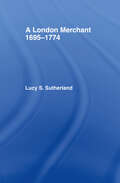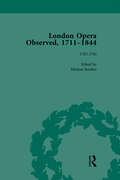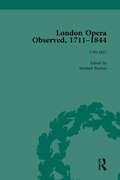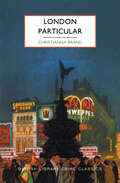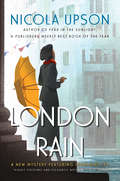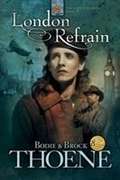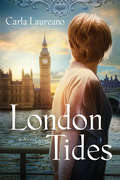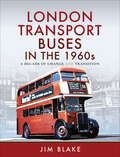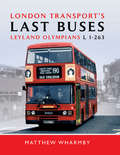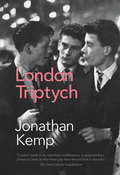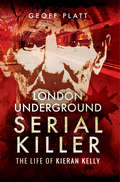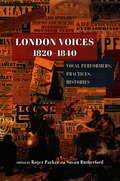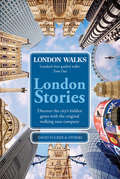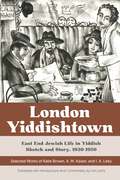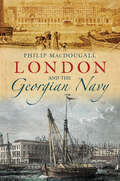- Table View
- List View
London Local Trains in the 1950s and 1960s
by Kevin McCormackThis remarkable colour album of 1950s and 1960s images covers non-express trains working in and out of London termini, along with a selection of feeder services operating in roughly a 40 mile radius of the Capital. The trains featured are therefore semi-fast passenger, suburban passenger and freights. The advantage of casting the net beyond services in and out of London itself is to increase the variety of locomotive types and diesel/electric units featured, making the book a thoroughly interesting read.Throughout, photographs with identifiable landmarks, for example stations and signal boxes, are used wherever possible. Furthermore, every effort has been made to show a wealth of material which has never been seen before.London Local Trains in the 1950s and 1960s is an in-depth and well-researched account of the London railway scene, that meticulously charts their progress throughout the mid-twentieth century.
London Merchant 1695-1774: A London Merchant
by Lucy Stuart SutherlandFirst published in 1962. Routledge is an imprint of Taylor & Francis, an informa company.
London Night and Day, 1951
by Old House BooksThis unusual and entertaining guide to the capital gives a snapshot of the best places to visit. Arranged by hour of the day, it takes the reader on a journey around 1950s London, from your morning walk to your visit to the Turkish Bath and late-night taxi home. Includes recommended restaurants (many of which still exist), the best stately homes to visit, a tour of the Thames and how to cope with the noise and dirt of a trip to the capital.
London Opera Observed 1711-1844, Volume I: 1711-1763
by Michael BurdenThe thrust of these five volumes is contained in their title, London Opera Observ’d. It takes its cue from the numerous texts and volumes which — during the seventeenth, eighteenth and nineteenth centuries — used the concept of ‘spying’ or ‘observing’ by a narrator, or rambler, as a means of establishing a discourse on aspects of London life. The material in this five-volume reset edition examines opera not simply as a genre of performance, but as a wider topic of comment and debate. The stories that surrounded the Italian opera singers illuminate contemporary British attitudes towards performance, sexuality and national identity. The collection includes only complete, published material organised chronologically so as to accurately retain the contexts in which the original readers encountered them — placing an emphasis on rare texts that have not been reproduced in modern editions. The aim of this collection is not to provide a history of opera in England but to facilitate the writing of them or to assist those wishing to study topics within the field. Headnotes and footnotes establish the publication information and provide an introduction to the piece, its author, and the events surrounding it or which caused its publication. The notes concentrate on attempting to identify those figures mentioned within the texts. The approach is one of presentation, not interpretation, ensuring that the collection occupies a position that is neutral rather than polemical.
London Opera Observed 1711-1844, Volume II: 1763-1782
by Michael BurdenThe thrust of these five volumes is contained in their title, London Opera Observ’d. It takes its cue from the numerous texts and volumes which — during the seventeenth, eighteenth and nineteenth centuries — used the concept of ‘spying’ or ‘observing’ by a narrator, or rambler, as a means of establishing a discourse on aspects of London life. The material in this five-volume reset edition examines opera not simply as a genre of performance, but as a wider topic of comment and debate. The stories that surrounded the Italian opera singers illuminate contemporary British attitudes towards performance, sexuality and national identity. The collection includes only complete, published material organised chronologically so as to accurately retain the contexts in which the original readers encountered them — placing an emphasis on rare texts that have not been reproduced in modern editions. The aim of this collection is not to provide a history of opera in England but to facilitate the writing of them or to assist those wishing to study topics within the field. Headnotes and footnotes establish the publication information and provide an introduction to the piece, its author, and the events surrounding it or which caused its publication. The notes concentrate on attempting to identify those figures mentioned within the texts. The approach is one of presentation, not interpretation, ensuring that the collection occupies a position that is neutral rather than polemical.
London Opera Observed 1711-1844, Volume III: 1783-1792
by Michael BurdenThe thrust of these five volumes is contained in their title, London Opera Observ’d. It takes its cue from the numerous texts and volumes which — during the seventeenth, eighteenth and nineteenth centuries — used the concept of ‘spying’ or ‘observing’ by a narrator, or rambler, as a means of establishing a discourse on aspects of London life. The material in this five-volume reset edition examines opera not simply as a genre of performance, but as a wider topic of comment and debate. The stories that surrounded the Italian opera singers illuminate contemporary British attitudes towards performance, sexuality and national identity. The collection includes only complete, published material organised chronologically so as to accurately retain the contexts in which the original readers encountered them — placing an emphasis on rare texts that have not been reproduced in modern editions. The aim of this collection is not to provide a history of opera in England but to facilitate the writing of them or to assist those wishing to study topics within the field. Headnotes and footnotes establish the publication information and provide an introduction to the piece, its author, and the events surrounding it or which caused its publication. The notes concentrate on attempting to identify those figures mentioned within the texts. The approach is one of presentation, not interpretation, ensuring that the collection occupies a position that is neutral rather than polemical.
London Opera Observed 1711-1844, Volume IV: 1799-1821
by Michael BurdenThe thrust of these five volumes is contained in their title, London Opera Observ’d. It takes its cue from the numerous texts and volumes which — during the seventeenth, eighteenth and nineteenth centuries — used the concept of ‘spying’ or ‘observing’ by a narrator, or rambler, as a means of establishing a discourse on aspects of London life. The material in this five-volume reset edition examines opera not simply as a genre of performance, but as a wider topic of comment and debate. The stories that surrounded the Italian opera singers illuminate contemporary British attitudes towards performance, sexuality and national identity. The collection includes only complete, published material organised chronologically so as to accurately retain the contexts in which the original readers encountered them — placing an emphasis on rare texts that have not been reproduced in modern editions. The aim of this collection is not to provide a history of opera in England but to facilitate the writing of them or to assist those wishing to study topics within the field. Headnotes and footnotes establish the publication information and provide an introduction to the piece, its author, and the events surrounding it or which caused its publication. The notes concentrate on attempting to identify those figures mentioned within the texts. The approach is one of presentation, not interpretation, ensuring that the collection occupies a position that is neutral rather than polemical.
London Opera Observed 1711-1844, Volume V: 1821-1844
by Michael BurdenThe thrust of these five volumes is contained in their title, London Opera Observ’d. It takes its cue from the numerous texts and volumes which — during the seventeenth, eighteenth and nineteenth centuries — used the concept of ‘spying’ or ‘observing’ by a narrator, or rambler, as a means of establishing a discourse on aspects of London life. The material in this five-volume reset edition examines opera not simply as a genre of performance, but as a wider topic of comment and debate. The stories that surrounded the Italian opera singers illuminate contemporary British attitudes towards performance, sexuality and national identity. The collection includes only complete, published material organised chronologically so as to accurately retain the contexts in which the original readers encountered them — placing an emphasis on rare texts that have not been reproduced in modern editions. The aim of this collection is not to provide a history of opera in England but to facilitate the writing of them or to assist those wishing to study topics within the field. Headnotes and footnotes establish the publication information and provide an introduction to the piece, its author, and the events surrounding it or which caused its publication. The notes concentrate on attempting to identify those figures mentioned within the texts. The approach is one of presentation, not interpretation, ensuring that the collection occupies a position that is neutral rather than polemical.
London Particular (British Library Crime Classics)
by Christianna BrandFirst published in 1952, London Particular was Christianna Brand's favorite among her own books, and it remains a fast-paced and witty masterpiece of the genre, showing off the author's signature flair for the ruthless twist. This edition includes an introduction by CWA Diamond Dagger and Edgar® Award–winning author Martin Edwards."You have to reach for the greatest of the Great Names (Agatha Christie, John Dickson Carr, Ellery Queen) to find Christianna Brand's rivals in the subtleties of the trade."—Anthony Boucher in the New York TimesNight falls in the capital, and a "London particular" pea-souper fog envelops the city. In Maida Vale, Rose and her family doctor Tedward struggle through the dark after a man has telephoned from Rose's house, claiming to have been attacked. By the time they arrive, the victim, Raoul Vernet, is dead. The news he brought from Switzerland for Rose's mother has died with him.Arriving to the scene, Inspector Cockrill faces a fiendish case with seven suspects who could have murdered their guest—family members and friends with alibis muddled by the suffocating fog and motives wrapped in mystery. Now, the race is on to find the truth before the killer strikes again.
London Rain: A New Mystery Featuring Josephine Tey
by Nicola UpsonIntrepid writer and amateur sleuth Josephine Tey returns in this sixth installment of Nicola Upson's popular series--perfect for fans of Agatha Christie's Hercule Poirot and Jaqueline Winspear's Maisie Dobbs--that unfolds in 1930s London as England prepares to crown a new king.London, 1937. Following the gloomy days of the abdication of King Edward VIII, the entire city is elated to welcome King George. Just one of the many planned festivities for the historic coronation is a BBC radio adaptation of Queen of Scots, and the original playwright, Josephine Tey, has been invited to sit in on rehearsals.Soon, however, Josephine gets wrapped up in another sort of drama. The lead actress has been sleeping with Britain's most venerable newsman, Anthony Beresford--and his humiliated wife happens to work in the building. The sordid affair seems to reach its bloody climax when Beresford is shot to death in his broadcasting booth at the deafening height of the coronation ceremony.Josephine's dear friend, Detective Chief Inspector Archie Penrose, has the case wrapped up before long. But when a second, seemingly related murder throws Penrose for a loop, it falls to Josephine to unravel a web of betrayal, jealousy, and long-held secrets... caught all the while in a love triangle of her own making.Charming and provocative, thick with the atmosphere of prewar England, London Rain is a captivating portrait of a city on the edge--and an unforgettable woman always one step ahead of her time.
London Refrain (The Zion Covenant, Book #7)
by Bodie Thoene Brock ThoeneEngland teeters on the brink of war. It's no longer a question of if. It's a matter of when. IN THE DARK FALL OF 1939, the hopes of the Polish people fade as Nazi bombers strafe the beloved city of Warsaw. Politicians debate while hundreds stand in lines at the British Embassy, desperate to flee the country before Hitler's ground forces arrive. Mac McGrath, a veteran American photographer, recorded the landslide toward war with dedication, believing that if he told the truth, the world would rise up and put a stop to Hitler's evil plans. Now his foolish idealism embarrasses him. Outside the embassy gates, Jewish schoolteacher Eva Weitzman prays for a miracle. Without a British passport, she will fall into the Nazis' clutches. Who will live and who will die? Will anyone dare to stand against the apathy of nations?
London Tides
by Carla LaureanoIrish photojournalist Grace Brennan travels the world's war zones documenting the helpless and forgotten. After the death of her friend and colleague, Grace is shaken. She returns to London hoping to rekindle the spark with the only man she ever loved--Scottish businessman Ian MacDonald. But he gave up his championship rowing career and dreams of Olympic gold years ago for Grace ... only for her to choose career over him. Will life's tides bring them back together ... or tear them apart for good this time?
London Transport (Regional Tramways)
by Peter WallerA history of London&’s horse, steam, cable, and electric tramways, and the operation that ended an era. Includes photos. The final volume in the Regional Tramways series focuses on the history of tram operation in the London area. Starting the story with the pioneering horse tramways operated by George Francis Train in the 1860s, the book narrates how the various horse, steam, cable, and electric tramways evolved in the period leading up to the creation of the London Passenger Transport Board in 1933. The primary focus of the book is the period immediately after World War II when, following the retention of the tramways for longer than anticipated, the process of conversion—codenamed Operation Tramaway—saw almost 1,000 trams eliminated from the streets of London in less than two years. Also covered are the two second-generation tramways—the Docklands Light Railway and Croydon Tramlink—which now serve parts of the Greater London area. The book concludes with an overview of those London trams that survive into preservation.
London Transport Buses in the 1960s: A Decade of Change and Transition
by Jim BlakeJust as life in Britain generally changed dramatically during the 1960s, so did London Transport's buses and their operations. Most striking was the abandonment of London's trolleybuses, once the world's biggest system, and their replacement by motorbuses. Begun in 1959 using surplus RT-types, it was completed by May 1962 using new Routemasters, designed specifically to replace them. They then continued to replace RT types, too. Traffic congestion and staff shortages played havoc with London Transport's buses and Green Line coaches during the 1960s, one-man operation was seen as a remedy for the latter, shortening routes in the Central Area for the former. Thus the ill-fated "Reshaping Plan" was born, introducing new O.M.O. bus types. These entered trial service in 1965, and after much delay the plan was implemented from September 1968 onwards. Sadly, new MB-types, also introduced in the Country Area, soon proved a disaster! Unfortunately, owing to a government diktat, Routemaster production ended at the start of 1968, forcing LT to buy "off-the-peg" vehicles unsuited to London operation and their in-house overhaul procedures. The decade ended with the loss of LT's Country Area buses and Green Line coaches to the National Bus Company. Photographer Jim Blake began photographing London's buses towards the end of the trolleybus conversion program in 1961 and continued dealing with the changing scene throughout the decade. He dealt very thoroughly with the "Reshaping" changes, and many of the photographs featured herein show rare and unusual scenes which have never been published before.
London Transport's Last Buses: Leyland Olympian L1-263
by Matthew WharmbyThe Olympian was Leyland's answer to the competition that was threatening to take custom away from its second-generation OMO double-deck products. Simpler than the London Transportcentric Titan but, unlike that integral model, able to respond to the market by being offered as a chassis for bodying by the bodybuilder of the customer's choice, the Olympian was an immediate success and soon replaced both the Atlantean and Bristol VRT as the standard double-decker of the NBC. It wasn't until 1984 that London Transport itself dabbled with the model, taking three for evaluation alongside trios of contemporary double-deckers.The resulting L class spawned an order for 260 more in 1986, featuring accessibility advancements developed by LT in concert with the Ogle design consultancy, but the rapid changes engulfing the organisation meant that no more were ordered. During the 1990s company ownerships shifted repeatedly as the ethos of competition gave way to the cold reality of big business, an unstable situation which even saw London's bus operations broken up.The L class was split between three new companies, but the backlog of older vehicles to replace once corporate interests released funding ensured the buses up to a further decade in service. Finally, as low-floor buses swept into the capital at the turn of the century, Olympian operation at last declined, and the final examples operated early in 2006.This profusely illustrated book describes the diversity of liveries, ownerships and deployments that characterised the London Leyland Olympians' two decades of service.
London Triptych
by Jonathan Kemp"London itself is as powerful a presence here as the three gay men whose lives it absorbs."?The Times Literary Supplement"Vivid and visceral, London Triptych cuts deep to reveal the hidden layers of a secret history."?Jake Arnott, author of The Long FirmRent boys, aristocrats, artists, and criminals populate this sweeping novel in which author Jonathan Kemp skillfully interweaves the lives and loves of three very different men in gay London across the decades.In the 1890s, a young man named Jack apprentices as a rent boy and discovers a life of pleasure and excess that leads to new friendships, most notably with the soon-to-be-infamous Oscar Wilde. A century later in 1998, David tells his own tale of unashamed decadence from prison, recalling life as a young man arriving in the city in the mid-'80s just as the scourge of AIDS hit. Where their paths cross, in the politically sensitive 1950s, when gay men were the target of police and politicians alike, the artist Colin tentatively explores his sexuality while working on his painting "London Triptych."Moodily atmospheric and rich with history, London Triptych is a sexy, resplendent portrait of the politics and pleasures of queer life in one of the world's most fascinating cities.Jonathan Kemp lives in London, where he currently teaches creative writing at Birkbeck College. London Triptych, his first novel, was published in the United Kingdom in 2010 and won the Authors' Club Best First Novel Award.
London Under: The Secret History Beneath the Streets
by Peter AckroydLondon Under is a wonderful, atmospheric, imaginative, oozing short study of everything that goes on under London, from original springs and streams and Roman amphitheaters to Victorian sewers, gang hideouts, and modern tube stations. The depths below are hot, warmer than the surface, and this book tunnels down through the geological layers, meeting the creatures, real and fictional, that dwell in darkness--rats and eels, monsters and ghosts. When the Underground's Metropolitan Line was opened in 1864, the guards asked for permission to grow beards to protect themselves against the sulfurous fumes, and named their engines after tyrants--Czar, Kaiser, Mogul--and even Pluto, god of the underworld. To go under London is to penetrate history, to enter a hidden world. As Ackroyd puts it, "The vastness of the space, a second earth, elicits sensations of wonder and of terror. It partakes of myth and dream in equal measure."From the Hardcover edition.
London Underground Serial Killer: The Life Of Kieran Kelly
by Geoff PlattThe full story of the life and times of Kieran Patrick Kelly, the London Underground Serial Killer, who wandered up and down the Northern Line of the London Underground between 1960 and 1983, pushing innocent people that he had never met under trains, and who finished up killing over thirty people. The book provides a full biography of Kelly, discussing the details of his crimes, his victims and his ability to evade justice; he managed to secure mistrials or acquittals in twenty-five trials before being eventually convicted and sentenced to die to prison, which he did in Durham, in 2001. It could be argued that Kelly is the most investigated serial killer in the history of the world. His murders were investigated as they occurred between 1953 and 1983; they were reinvestigated in 1983 and again in 2015. The author of this book played major roles in the two latter inquiries, conducting the entire inquiry in 1983 and acting as a consultant to the 2015 inquiry. More is known about Kelly than any other serial killer in history. He was arrested before he had finished killing, then murdered his cellmate in the police station and was interviewed by the author ten minutes after this final murder, before spending the next two years discussing his crimes and his motivations with the author. The end result is a truly unique insight into the mind of a serial killer!
London Voices, 1820–1840: Vocal Performers, Practices, Histories
by Susan Rutherford Roger ParkerLondon, 1820. The British capital is a metropolis that overwhelms dwellers and visitors alike with constant exposure to all kinds of sensory stimulation. Over the next two decades, the city’s tumult will reach new heights: as population expansion places different classes in dangerous proximity and ideas of political and social reform linger in the air, London begins to undergo enormous infrastructure change that will alter it forever. It is the London of this period that editors Roger Parker and Susan Rutherford pinpoint in this book, which chooses one broad musical category—voice—and engages with it through essays on music of the streets, theaters, opera houses, and concert halls; on the raising of voices in religious and sociopolitical contexts; and on the perception of voice in literary works and scientific experiments with acoustics. Emphasizing human subjects, this focus on voice allows the authors to explore the multifaceted issues that shaped London, from the anxiety surrounding the city’s importance in the musical world at large to the changing vocal imaginations that permeated the epoch. Capturing the breadth of sonic stimulations and cultures available—and sometimes unavoidable—to residents at the time, London Voices, 1820–1840 sheds new light on music in Britain and the richness of London culture during this period.
London Walks: London Stories
by David TuckerLondon Walks is the award-winning original walking tour company. Written by the expert and knowledgeable guides who lead the walks, London Stories is the perfect way to discover the rich history of London and its hidden gems, including:Sinister London - haunted London and Jack the Ripper.Literary London - from Shakespeare to Dickens.Public Houses - the old pubs of Soho. Mystery and Secrets - the city's hidden past.A Tale of Two Cities - Westminster and the Square Mile.Perfect for tourists who want to experience London life beyond Trafalgar Square as well as for Londoners keen to step off the Circle Line and discover the secrets on their own doorstep, London Stories offers a fascinating glimpse into the capital's rich history. With photos, maps and illustrations to bring the stories to life, London Stories is for those who love London, written by those who know it best.
London Yiddishtown: East End Jewish Life in Yiddish Sketch and Story, 1930–1950: Selected Works of Katie Brown, A. M. Kaizer, and I. A. Lisky
by Katie Brown I. A. Lisky A. M. KaizerIn London Yiddishtown: East End Jewish Life in Yiddish Sketch and Story, 1930–1950, Vivi Lachs presents a selection of previously un-translated short stories and sketches by Katie Brown, A. M. Kaizer, and I. A. Lisky, for the general reader and academic alike. These intriguing and entertaining tales build a picture of a lively East-End community of the 30s and 40s struggling with political, religious, and community concerns. Lachs includes a new history of the Yiddish literary milieu and biographies of the writers, with information gleaned from articles, reviews, and obituaries published in London’s Yiddish daily newspapers and periodicals. Lisky’s impassioned stories concern the East End’s clashing ideologies of communism, Zionism, fascism, and Jewish class difference. He shows anti-fascist activism, political debate in a kosher café, East-End extras on a film set, and a hunger march by the unemployed. Kaizer’s witty and satirical tales explore philanthropy, upward mobility, synagogue politics, and competition between Zionist organizations. They expose the character and foibles of the community and make fun of foolish and hypocritical behavior. Brown’s often hilarious sketches address episodes of daily life, which highlight family shenanigans and generational misunderstandings, and point out how the different attachments to Jewish identity of the immigrant generation and their children created unresolvable fractures. Each section begins with a biography of the writer, before launching into the translated stories with contextual notes. London Yiddishtown offers a significant addition to the literature about London, about the East End, about Jewish history, and about Yiddish. The East End has parallels with New York’s Lower East Side, yet London’s comparatively small enclave, and the particular experience of London in the 1930s and the bombing of the East End during the Blitz make this history unique. It is a captivating read that will entice literary and history buffs of all backgrounds. A Yiddish Book Center Translation.
London and Paris Through Indian Spectacles
by G. Paramaswaran Pillai Usha SahanaThe book is structured in the form of a series of sketches, usually about people, and it is here that Piliai's powers of observation and human sympathy are most evident. Whether it is his landlady, a policeman, a bus driver, or a waiter, Pillai makes the individual as well as the institution come alive. There is also a wealth of sociological and historical detail which emerges from the travelogue.
London and its Asylums, 1888-1914: Politics and Madness (Mental Health in Historical Perspective)
by Robert EllisThis book explores the impact that politics had on the management of mental health care at the turn of the nineteenth and twentieth centuries. 1888 and the introduction of the Local Government Act marked a turning point in which democratically elected bodies became responsible for the management of madness for the first time. With its focus on London in the period leading up to the First World War, it offers a new way to look at institutions and to consider their connections to wider issues that were facing the capital and the nation. The chapters that follow place London at the heart of international networks and debates relating to finance, welfare, architecture, scientific and medical initiatives, and the developing responses to immigrant populations. Overall, it shines a light on the relationships between mental health policies and other ideological priorities.
London and the Cit
by Jade SinwellIn Regency London, where proper behavior is de rigueur, Sir Rudoph Shaw anything but proper. Born to wealthy parents, he loses everything after his father dies when he is only fourteen years old and, now going by plain Rudy Shaw, he is forced to make his own way on the cruel streets of London.But Rudy’s fortunes are changing. He runs into a childhood friend who pulls him back into the world of the rich and powerful, giving Rudy a second chance at the life he should have had. That is, if Rudy can keep his darkest secrets hidden from the world -- first, that he is only a lowly destitute laborer who has sold his body in the past to put food in his belly and, even more devastating if it is revealed, he prefers men in his bed.Upon Rudy’s debut back into the shining world of well-off Londoners, he learns the man whom he has been having a year-long affair with is none other than the affianced husband to his friend’s cousin. If this secret gets out, Rudy will be ruined for sure. Can the two men stay away from each other? Or will their passion and love destroy them both?
London and the Georgian Navy
by Philip MacDougall Philip MacdougallAt a time when the Royal Navy was the biggest and best in the world, Georgian London was the hub of this immense industrial-military complex, underpinning and securing a global trading empire that was entirely dependent on the navy for its existence. Philip MacDougall explores the bureaucratic web that operated within the wider city area before giving attention to London’s association with the practical aspects of supplying and manning the operational fleet and shipbuilding, repair and maintenance. His supremely detailed geographical exploration of these areas includes a discussion of captivating key personalities, buildings and work. The book examines significant locations as well as the importance of Londoners in the manning of ships and how the city memorialised the navy and its personnel during times of victory. An in-depth gazetteer and walking guide complete this fascinating study of Britain, her capital and her Royal Navy.

